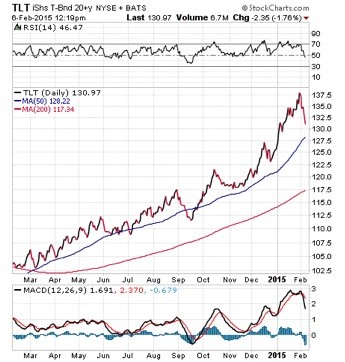Why the Dollar Rises as Stocks Stall and Bonds Fall
Post on: 17 Июль, 2015 No Comment

Stocks Stall, Bonds Fall and the Dollar Spikes
The February jobs report was the big news this week, and the better-than-expected data caused traders to fear the Federal Reserve might pull the trigger on that long-awaited interest rate hike as soon as the June Federal Open Market Committee (FOMC) meeting.
The data from the Labor Department released this morning showed that employers added 295,000 new jobs during the month, well above the consensus estimate that called for only a 235,000 job increase. The unemployment rate also fell from 5.7% to 5.5%, the lowest that metric has been in almost seven years.
The reaction from traders caused stocks to stall, bond prices to fall and the value of the U.S. dollar vs. rival foreign currencies to spike. In fact, the U.S. dollar has been on a mighty run so far in 2015, with the benchmark U.S. Dollar Index ETF, the PowerShares DB US Dollar Bullish (UUP). up nearly 8%. I remember when a 4% annual spike in the value of the greenback was considered an unusually volatile year for the dollar. Now, currency traders are doubling that gain in just over nine weeks.
A weaker euro, along with a weaker Japanese yen, largely has been supporting the relative value of the dollar here. Today, however, the notion of a potential rate hike in June is fueling dollar bulls to go long in the greenback via UUP.
This trend higher in the dollar is a circumstance likely to continue. While a stronger dollar is generally good for consumers, it could have the very negative effect of what’s called an “earnings recession” for multi-national companies that do most of their business in exports.
If you want to get a glimpse of what could be a strong dollar-inspired headwind on corporate earnings going forward, then keep an eye on UUP.
ETF Talk: This Fund is Always Golden
One of the many uses of exchange-traded funds (ETFs) is their ability to allow investors exposure to commodities without having to worry about futures contracts or owning the underlying physical commodity. The SPDR Gold Shares (GLD) is one such ETF, giving investors the capability to invest in physical gold bullion without having to handle buying and selling it themselves.
Gold often is used as an investment because its performance tends to run counter to the stock market. This potential rise in gold is due to its innate value, since it traditionally is seen as a safe haven for assets in treacherous markets. Historically, gold performs well when the market goes down, so the precious metal can provide a good way to make money in rough times.
In 2014, GLD lost 2.19% of its value, as investors primarily chose to speculate in riskier equities while market sentiment was bullish. So far this year, though, GLD has risen 1.25%, as the market has been more volatile. GLD’s $27.4 billion in assets correspond to its holdings and may fluctuate with the price of gold.
GLD is the world’s ninth-largest ETF. Though GLD carries a 0.40% expense ratio, buying and selling physical gold would incur expenses that would likely be far greater, so the fund still provides an attractive possibility for gold ownership without the hassle of finding a place to store it safely.
Gold has fallen a long way from its 2011 heights. That drop suggests it may have room to run, especially if the stock market undergoes a concerted pullback. For gold bugs and investors who think now is the time for a golden rally, you won’t find a more direct ETF investment than SPDR Gold Shares (GLD) .
If you want my advice about buying and selling specific ETFs, including appropriate stop losses, please consider subscribing to my Successful ETF Investing newsletter. As always, I am happy to answer any of your questions about ETFs, so do not hesitate to send me an e-mail. You just may see your question answered in a future ETF Talk.
Top 10 ETFs for 2015
The start to the 2015 market certainly has been a wild ride.
Steep declines in stocks due to a huge drop in oil prices characterized most of January, but a February rally by the bulls brought stocks back to new highs in the S&P 500 and turned the tables on the timid bears.
Now, more than ever, you need to be equipped with the knowledge required to take advantage of what this market throws at you and one of the best ways to do that is to know which exchange-traded funds (ETFs) can give your portfolio the edge against uncertainty, volatility and the prevailing trends in the equity, bond and commodities markets.

To help you identify the best of the best ETFs for 2015, we’ve put together a special YouTube video presentation:
In this insightful presentation, you’ll find out which ETFs we think are poised to deliver outstanding performance this year. More importantly, you’ll find out all about the underlying trends operating in the market right now and why these trends are likely to propel these specific ETFs higher during the next 11-plus months.
Whether your main investment objective is to grow your assets or to generate income from existing assets, the “Top 10 Best ETFs for 2015” has something for you.
NOTE: Fabian Wealth Strategies is a SEC registered investment adviser, and is not affiliated with Eagle Financial Publications.
ETFs for India’s New Bull Market
India is doing great. The population is well educated, the demographics are fabulous and the political leadership is pro market and generally committed to implementing pro-growth economic policies.
Now, recall that last year we pounded the table on the Chinese bull market, while telling you about the numerous ETFs you could use to gain exposure to the Chinese equity markets.
This year, India could be the country that rides a new bull wave. Because of this possibility, you need to be aware of all of the ETFs you can use to take advantage of India’s new bull market.
The table below shows the top seven funds pegged to the India equity market. The rankings are from the highest to lowest in terms of assets under management, or AUM.














